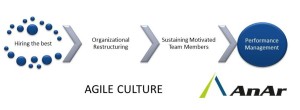Building an Agile Organisation : Strategic HR is key to success!
It is extremely critical to manage the most basic asset of a company, i.e. people; and HR plays a major role in that. In an Agile organization there is a need to connect with the team mates on a regular basis to keep them abreast of things within the organization and around it.
The word “agility” is complex: it refers to strategy, leadership, management, and learning. As the world becomes increasingly volatile and unpredictable, organizations that are agile will outpace their competitors. To become a critical driver of agility, HR must fundamentally reshape itself to enable a new type of organization—one designed around highly nimble and responsive talent.
Agile organizations evolve their strategy but deepen it where they have strength. Their leaders drive execution but they also empower people. Management is thin, hands-on, and highly engaged. And people and teams are constantly learning.
Concerns like Job Security, loss of privacy due to the open work environment, Fear of loss of individual identity etc.; arise among the team members amidst transformation to Agile.
The Human Resources department of the company can play an important role in addressing these concerns. It can be a strategic, innovative partner in the company’s Agile-adoption journey.
- An HR department can start with redefining or enhancing their recruitment engine – Hiring a team member with right attitude and mind-set is the first step toward building an Agile organization. The focus should be to get the right individual, one who fits the organizational and team culture. Hiring a good manager who has an Agile mind-set is as important as hiring an Agile developer
- The next important thing on the HR’s task list should be – to define the structure of the new, flexible roles and responsibilities and to address any problems team have during the transition
- Further comes an important task of performance management. Moving from Individual performance reviews to team based performance reviews help team members gain confidence
Many such things can be listed down and would detail out in the blogs to come!
At AnAr we all connect on every Monday Morning and share our experiences to have a rock-solid start for the week. It is at the heart of all communications within the organization comes across – Be it team member specific information or company news everything discussed here!
After all happy team members translate into delighted customers!
http://www.anarsolutions.com/building-an-agile-organisation-strategic-hr-is-key-to-success/utm_source=Blogger.com 




